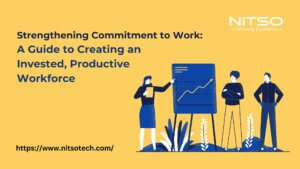Declining markets present challenges for businesses to maintain revenue and profitability. However, it also represents an opportunity to refocus on internal operations and strengthen your team. Employee engagement will be a key driver of team performance during difficult economic conditions. Engaged employees are more productive, creative, and loyal to the company. This article will provide tips for improving employee engagement to boost team performance when facing declining markets.
The current economic climate has led many companies to face declining revenue and increased cost pressures. Though the external environment seems out of our control, it allows an opening to concentrate energy internally. Teams and organizations can emerge stronger by focusing on employee engagement and performance. Engaged workers are more invested in driving business results during both good times and bad.
Boosting engagement won’t happen by itself. Leaders need to make it a priority through thoughtful programs and initiatives. The rest of this article will provide strategies to improve engagement, which leads to better team performance even in down markets.
Table of Contents
Why Employee Engagement Matters?
It’s essential to understand why employee engagement deserves focus during declining markets. Engaged employees lead to improved productivity, profitability, retention, and loyalty – outcomes that every organization needs but are harder to achieve when facing external challenges.
Multiple research studies have shown that companies with highly engaged workforces outperform peers on key financial metrics as well as on intangible measures like innovation and employee retention. According to Gallup, business units in the top quartile for engaged employees see 21% higher profitability.
Declining markets make it even more difficult to maintain engagement as uncertainty rises and priorities shift to trimming costs. However, engagement becomes even more crucial during turbulent times. Engaged employees go above and beyond to help the company succeed despite challenges. They have higher loyalty and discretionary effort.
Rather than looking at engagement initiatives as extra costs, leaders should see them as investments that lead to higher productivity, performance, and profits. Engagement drives results. The rest of this article outlines ways to boost employee engagement that pay rewards for the whole organization.
Ways to Boost Employee Engagement
There are many tactics and strategies leaders can use to improve engagement. It’s crucial to understand your unique organizational culture and values when designing engagement plans. While some ideas may work across companies, the most impactful initiatives will align with your existing strengths.
Below are effective ways to boost employee engagement:
1. Listen to Employees
The first step is listening to employees to understand their concerns, needs, and ideas. Send out frequent pulse surveys to check on how people are feeling about their work experience. Make surveys anonymous to encourage honest feedback. Follow up quickly on suggestions and concerns raised. Hold skip-level meetings for managers to hear directly from their direct reports. Look at employee feedback as an opportunity to improve.
2. Improve Transparency and Communication
With market uncertainty, rumours and ambiguities often fill the void of direct communication. Set up regular company-wide town halls for leadership to share business updates. Arm managers with talking points to hold smaller team meetings. Use enterprise communication platforms to encourage ongoing dialogue. Clarify decision-making criteria, priorities and tradeoffs. Ensure information reaches all employees, not just senior leaders.
3. Offer Development and Growth Opportunities
Career development initiatives are highly valued by employees. Make training and development a priority even in down markets. Look into free online courses and workshops. Offer stretch assignments and internal mobility to expand skills. Start mentorship and coaching programs to build connections. Outline clearer career paths and skills needed for advancement. Support employees’ long-term employability.
4. Recognize and Reward Contributions
Appreciation remains important even with tighter budgets. Look for no-cost ways to recognize achievements from public shoutouts to award certificates. Institute peer recognition programs for employees to appreciate each other. Share successes and milestones broadly. If budgets allow, consider spot bonuses or extra time off for top performers. Have leaders send personalized thank-you notes.
5. Build Trust, Empathy and Relationships
Difficult times can strain relationships and erode trust. Foster deeper connections between employees and with leadership through open conversations. Encourage vulnerability and sharing challenges. Provide coaching for leaders on demonstrating empathy and support. Allow teams to set aside time for non-work discussions and relationship building. Facilitate opportunities for cross-department collaborations.
6. Empower Employees
Engagement rises when employees feel ownership over their work. Delegate decision-making authority when possible. Solicit ideas for improving processes and solving problems. Remove bureaucratic hurdles that disempower employees. Have skip-level meetings for senior leaders to hear ideas directly from the frontlines. Trust employees to do their best work.
Connecting Engagement to Performance
After outlining ways to improve engagement, it’s important to make the case for how engagement drives performance. There is substantial research showing the correlation between engaged employees and organizational success according to various metrics.
Productivity
Gallup has found that highly engaged business units have 21% higher productivity than those with low engagement. Engaged employees meet goals more effectively and are more motivated to contribute discretionary effort. They are also more likely to share ideas for efficiency improvements.
Profitability
Higher productivity translates directly to the bottom line. Gallup found that engaged teams show 21% higher profitability. Quantum Workplace saw a correlation of up to 19% higher revenue for highly engaged organizations. Engaged employees make smarter decisions that save on costs.
Safety
Engaged employees have 41% fewer safety incidents according to Gallup. They follow safety guidelines more diligently. Greater focus and care for their work leads to fewer on-the-job accidents.
Retention
Replacing employees is hugely expensive – up to two times the annual salary for high-turnover roles. Engaged employees have higher retention and lower turnover. Gallup found high engagement leads to 59% lower turnover. Employee retention becomes even more crucial during hiring freezes.
Discretionary Effort
Engaged employees give extra effort beyond their core responsibilities. An IBM study found that in engaged teams, 84% went above and beyond versus 30% in disengaged groups. Discretionary effort is key for innovation and driving change, especially when facing challenges.
Customer Loyalty
Higher engagement leads to better customer experiences. IBM saw customer loyalty metrics improve by up to 20% in engaged teams. Engaged employees provide better service and can empathize with customer needs.
Key Takeaways and Conclusion
The current downturn provides an opening to focus internally and boost employee engagement. Though the external environment is tough, engagement initiatives can strengthen organizational performance from the inside out.
As discussed in this article, there are many tactics to improve engagement centring on open communication, development opportunities, recognition, trust building, and empowerment. Leaders should use pulse surveys and employee feedback to design initiatives tailored to their culture.
Employee engagement must be a priority in both good times and bad. However, it becomes even more crucial during declining markets as engaged employees display higher productivity, discretionary effort, and loyalty. They are key to driving performance when it’s needed most.
Investing in employees through engagement initiatives generates returns across the whole organization. Companies that make engagement a focus will be better positioned to weather economic challenges and gain competitive advantage. Teams and organizations emerge stronger by unleashing the full potential of their people.
FAQs
Why is employee engagement more important during declining markets?
Engaged employees are key to driving performance when revenue is shrinking. Their productivity, discretionary effort, and loyalty boost results.
What are some low-cost ways to improve engagement?
Frequent pulse surveys, peer recognition programs, public shoutouts, thank you notes from leadership and skip-level meetings.
How can you tell if employees are disengaged?
Signals include high absenteeism, low productivity, negative attitudes, lack of initiative and high turnover.
How long does it take to see the tangible benefits of engagement initiatives?
While some improvements are immediate, it takes sustained effort over months and years to build a highly engaged workforce.
How can leaders make the case for investing in engagement during layoffs and cost cutting?
Frame engagement as an investment not an expense. The returns from boosted performance outweigh the costs.
What are the most impactful engagement initiatives to prioritize first?
Start with foundational initiatives like pulse surveys, open communication, transparency and providing development opportunities.
How can you measure the ROI of engagement programs?
Track productivity, profitability, retention, safety metrics and discretionary effort before and after implementation.
What happens if you ignore engagement during difficult times?
Declining engagement will spiral and lead to plummeting productivity, job dissatisfaction, attrition and reduced innovation.
How can companies maintain engagement while transitioning to remote work?
Increase online interactions, provide at-home office stipends, train managers to manage remote teams and use virtual team building.








0 Comments